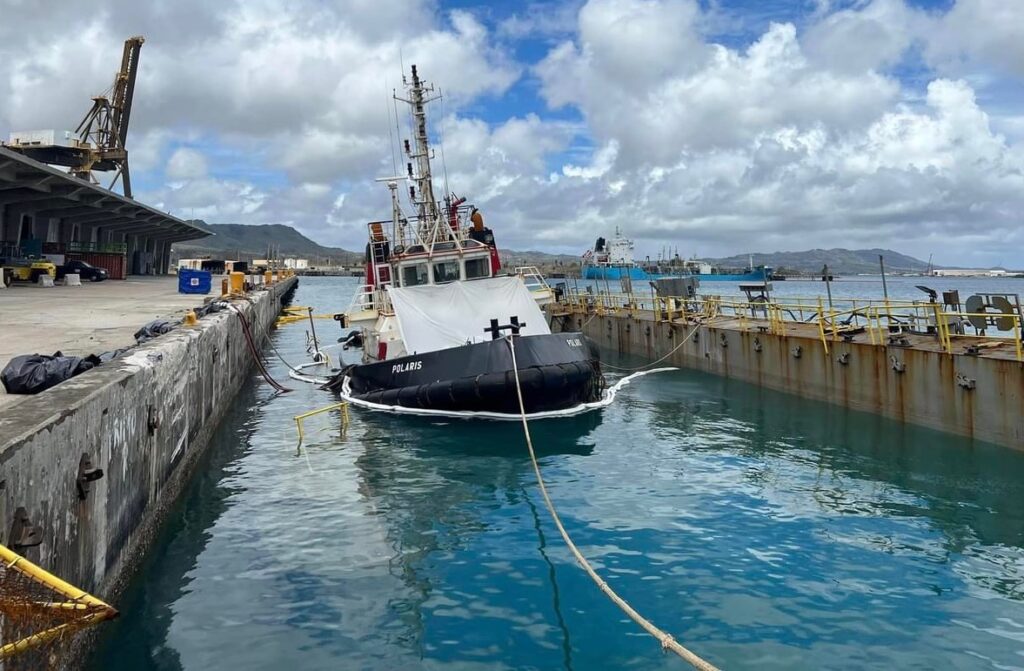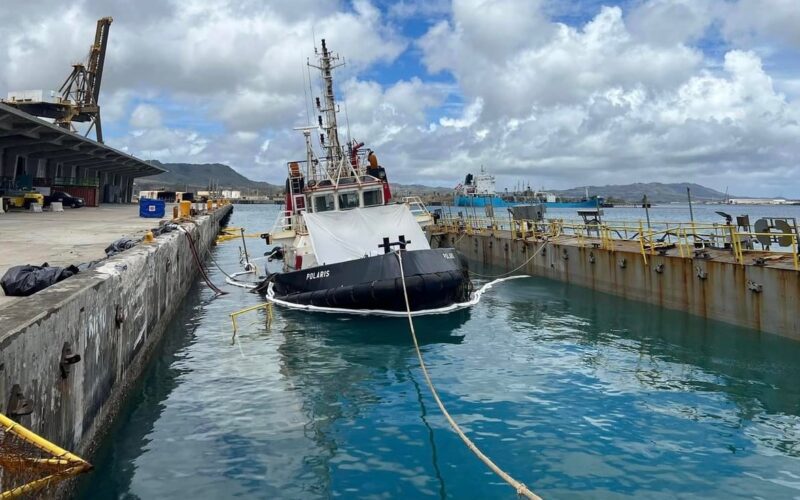(SANTA RITA, Guam) — In the aftermath of Typhoon Mawar, personnel from U.S. Coast Guard Forces Micronesia/Sector Guam continue to address vessel casualties and potential pollution in Apra Harbor, Hagatna Boat Basin and Agat Marina. With sustained winds of up to 150 mph, the storm caused significant damage to maritime infrastructure.
Capt. Nick Simmons, commander of U.S. Coast Guard Forces Micronesia/Sector Guam, emphasized the captain of the port’s responsibility for pollution response and commercial vessel safety.
“We are committed to ensuring the safety and protection of our waters,” he said. “Our collaboration with port partners has been exceptional, and I would like to extend my gratitude for their diligence and cooperation during this challenging time.”

Initial observation reports indicated three barges, two mobile crane barges and a derelict vessel broke free from commercial piers and grounded in the Piti Channel, while the dry dock at Cabras partially submerged near Pier F3 with the tugboat Polaris.
“We are aware and engaged on all vessel casualties related to the storm. Our teams are actively monitoring the situation to ensure a swift and effective response,” said Simmons.
The sailboat Pros is the only vessel confirmed to be sunken. Responders issued the owner a captain of the port order to provide a salvage plan, or risk federal intervention. The Cabras tug Polaris, which was partially submerged, has been successfully refloated by T&T Salvage. The Cabras tug Magas, sister tug to Polaris, was initially soft aground but has since been freed.
The next priority is addressing the mostly submerged Cabras dry dock, and the company engaged the services of T&T Salvage to handle the situation.
In the harbor of refuge, there are two barges and one derelict vessel aground, which pose no pollution potential or hazard to navigation. Cabras plans to salvage these vessels.
To mitigate potential pollution risks, responders continue conducting regular harbor patrols to monitor existing issues and identify any new hazardous materials or pollution items. Since May 24, responders identified 19 commercial or private vessels affected by the storm.
While these vessels potentially contained limited quantities of gasoline, diesel fuel and hydraulic oil, they did not pose a hazard to navigation. Most vessel owners have proactively taken the necessary steps to remove and restore their vessels by contracting professional services.
The Coast Guard swiftly responded to the aids to navigation (ATON) crisis created by the storm, mobilizing the USCGC Sequoia (WLB 215) crew alongside the dedicated personnel of Coast Guard Station Apra Harbor and the Maritime Safety and Security Team Honolulu.
The support of Coast Guard Regional Dive Locker Pacific, Explosive Ordnance Disposal Mobile Unit Five, and the U.S. Naval Mobile Construction Battalion One Detachment Guam further augmented the combined efforts of these units. Coupled with efforts from commercial port partners, their collective expertise allowed for surveying underwater areas, efficient movement of ATON supplies, and effective clearance of submerged obstacles.
As a result of their tireless work, the Port of Guam reopened in just three days, providing vital relief and support to the affected communities. The islands of Saipan and Tinian restored their ports sooner, having suffered less damage. While a few aids still require permanent repairs, these issues have been communicated through broadcast notice to mariners, ensuring continued awareness and transparency.
– U.S. Coast Guard

